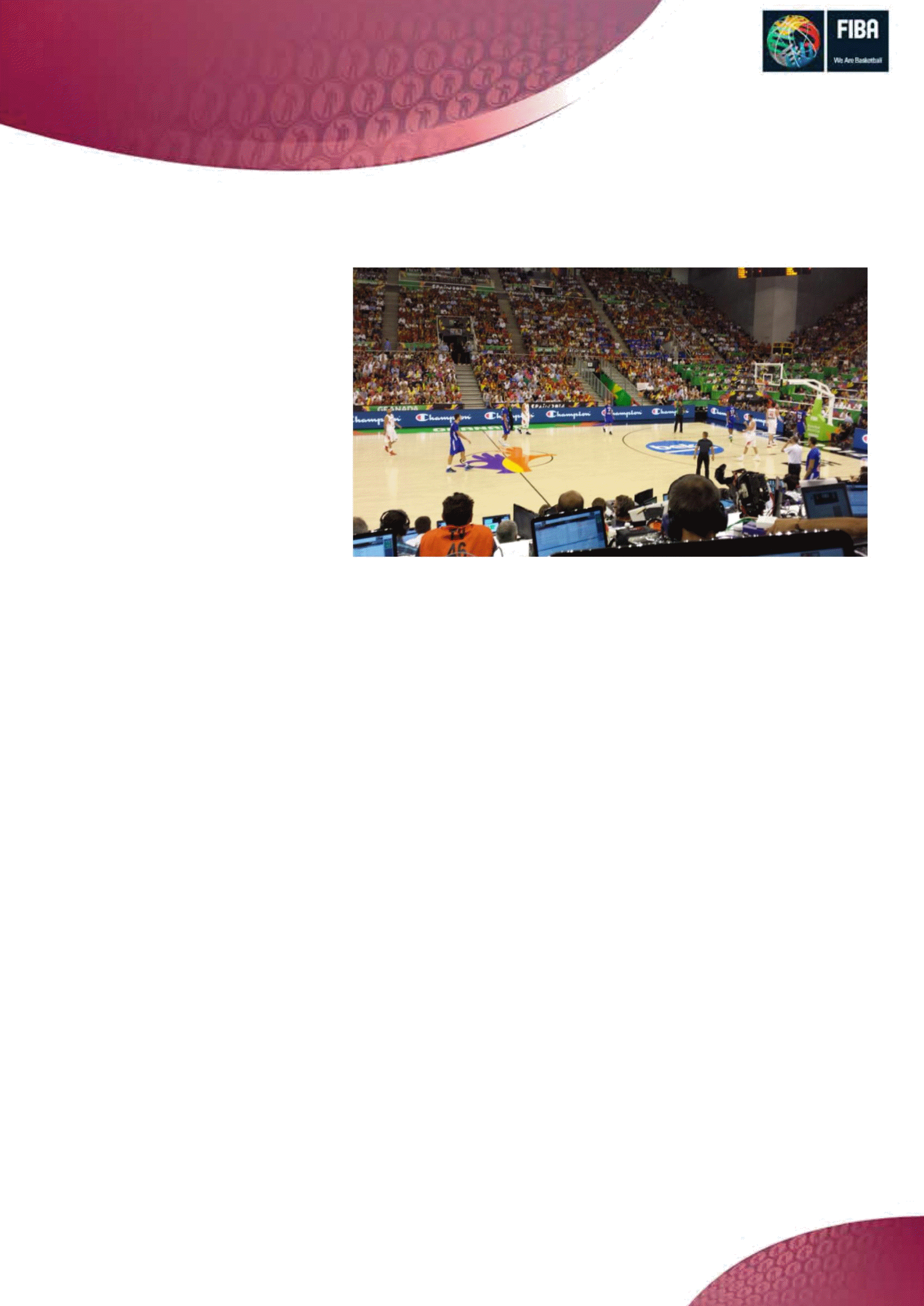
- •1. Introduction
- •2. Officials, table officials and commissioner
- •2.1 Who are they?
- •2.2 Personal attributes
- •2.3 Behaviour – Code of Conduct
- •3. Table officials common duties
- •3.1 Nomination
- •3.2 Arrival at the venue
- •3.3 Dress code
- •3.4 Meeting of Table Officials
- •3.6 Duties during the game
- •3.7 Post-game duties
- •4. The scorer
- •4.1 Scorer’s duties
- •4.2 Scorer’s equipment and necessary materials
- •4.3 The official scoresheet
- •4.4 Fiba official scoresheet
- •4.5 Records – before the game
- •4.5.1 Scoresheet header
- •4.5.2 Recording teams: players and coaches
- •4.5.3 Starting five and coaches’ signatures
- •4.5.4 Procedure in case of game lost by forfeit
- •4.6 The running score – During the game
- •4.6.1 Scores
- •4.6.2 Possible mistakes and solutions
- •4.6.3 Player and team fouls
- •Unsportsmanlike foul & after 2 uf (gd) d disqualifying foul for player & coach f disqualifying foul for fighting art.39
- •4.6.4 Team fouls
- •4.6.5 When substitutes enter the game for the first time
- •4.6.6 Time-outs
- •4.6.7 End of period or interval of play
- •4.6.8 Procedure in case of game lost by default.
- •4.7 Time out and substitution requests
- •4.7.1 Time-out request
- •In any case that irs is used, for both teams after the final decision.
- •4.7.2 Substitution requests
- •4.8 At the end of the game
- •4.8.1 Recording the final score
- •4.8.2 Finish the footer and signature of the crew
- •4.9 Summary pen colours
- •4.10 Alternating possession arrow
- •4.10.1 Positioning the alternating possession arrow
- •4.10.2 Operating the alternating possession arrow
- •4.11 Mechanics and performance standards
- •5. The assistant scorer
- •5.1 Assistant scorer’s duties
- •5.2 Before the game
- •5.3 During the game
- •5.4 Intervals of play
- •5.5 End of game and post-game
- •6. The timer
- •6.1 Timer´s duties
- •6.2 Required equipment and necessary materials
- •6.3 Before the game
- •6.3.1 Checking the device, sound and displays
- •6.3.2 Game clock
- •6.3.3 Sound signals
- •6.4 During the Game
- •6.4.1 Playing Time
- •6.4.2 Intervals of play
- •7.3 Before the Game
- •7.3.1 The shot clock device
- •7.3.2 Checking the device, signal sound and display
- •7.4 The Rule
- •7.4.1 Shot Clock
- •7.4.2 Control of the ball
- •7.4.3 The shot clock count
- •If the shot clock signal sounds in error while a team has control of the ball or neither team has control of the ball, the signal shall be disregarded and the game shall continue.
- •7.4.4 Shot clock operator
- •7.4.5 Examples of 24 / 14 seconds situations.
- •7.5 During the Game
- •7.5.1 24” / 14” Guidelines
- •7.5.2 Mechanics summary
- •7.5.3 Shot clock mistakes
- •7.6 Intervals of play and after the game
- •7.6.1 Help partners:
- •1.1 Requirements
- •1.2 Installing the Software
- •1.3 Starting a new game
- •1.4 The Main Window
- •1.5 Printing / process for signing scoresheet
- •After starting Digital Scoresheet a message is shown indicating that a software update is available - what should I do?
- •There are two fouls called, which should be marked with a ”c” (cancelled) on the paper scoresheet. How can this be entered?

TABLE OFFICIALS MANUAL 2017+ draft version 5.0
Version 1.0 (May 2017)

FOREWORD
FIBA has a commitment to facilitate and supervise the development of all FIBA family members. As key members of the refereeing team, Table Officials are an important part of this family.
With referees and commissioners, their role is crucial in ensuring the smooth running of basketball ga-mes worldwide.
Therefore the first edition of the Table Officials’ Manual is a logical progression in the implementation of the global Refereeing Development Strategic Plan, which commenced in 2014.
Modern basketball is a highly technical sport and all the participants must meet its ever-changing requi-rements. That is why this Manual is so important to serving not only FIBA Main Competitions but also any National level Competitions.
Bearing the above in mind, it is a pleasure to be able to present this work and to also thank all the people who have made its release possible, with more than 2 years of an unconditional contributions.
The intention of the 1st edition of this Table Officials’ Manual is to have a dynamic and practical working tool which can be improved with your active participation. FIBA has already started working on the 2nd edition of the Manual as part of its continuous improvement program.
For any suggestions or if you spot a mistake, please send your comments to refereeing@fiba.com
Thank you for your contribution in striving for excellent in worldwide basketball officiating.
FIBA Referee Department
2
Throughout the Table Officials Manual, all references made to a player, coach, official, etc., in the male gender also apply to the female gender. It must be understood that this is done for practical reasons only.
TABLE OF CONTENTS
1. INTRODUCTION 6
2. OFFICIALS, TABLE OFFICIALS AND COMMISSIONER 8
2.1 Who are they? 8
2.2 Personal attributes 8
2.3 Behaviour – Code of Conduct 10
3. TABLE OFFICIALS COMMON DUTIES 12
3.1 Nomination 12
3.2 Arrival at the venue 12
3.3 Dress code 12
3.4 Meeting of Table Officials 13
3.5 Pre-game duties 13
3.6 Duties during the game 14
3.7 Post-game duties 15
4. THE SCORER 17
4.1 Scorer’s duties 17
4.2 Scorer’s equipment and necessary materials 17
4.3 The official scoresheet 18
4.4 FIBA official scoresheet 18
4.5 Records – before the game 19
4.6 The running score – During the game 21
4.7 Time out and substitution requests 35
4.8 At the end of the game 45
4.9 Summary pen colours 46
4.10 Alternating possession arrow 48
4.11 Mechanics and performance standards 51
5. THE ASSISTANT SCORER 54
5.1 Assistant scorer’s duties 54
5.2 Before the game 54
5.3 During the game 55
5.4 Intervals of play 56
5.5 End of game and post-game 56
6. THE TIMER 58
6.1 Timer´s duties 58
6.2 Required equipment and necessary materials 58
6.3 Before the game 58
6.4 During the Game 59
6.5 After the Game 63
3
7. THE SHOT CLOCK OPERATOR 65
7.1 Shot clock operator’s duties 65
7.2 Required equipment and necessary material 65
7.3 Before the Game 65
7.4 The Rule 66
7.5 During the Game 78
7.6 Intervals of play and after the game 81
APPENDIX A – WHISTLE-CONTROLLED TIME SYSTEM 83
APPENDIX B – DIGITAL SCORESHEET USER MANUAL 86
1.1 Requirements 86
1.2 Installing the Software 86
1.3 Starting a new game 87
1.4 The Main Window 89
1.5 Printing / process for signing scoresheet 92
1.6 FAQ 93
4

INTRODUCTION

1. Introduction
Basketball is a constantly evolving sport. Conceived by Mr. Naismith, as an indoor school activity played during the winter, is now played in 215 countries. In many of these countries basketball is played at a professional level.
The increasing technical level of teams
leagues must be accompanied by an increase in the technical level of the officiating team (referees and table officials) to ensure the smooth running of each game.
An increase in electronic media pre-sence means the work of table officials
is constantly in the public eye, for example by showing the running score, the time left to play or the time left for a shot.
This Table Officials Manual aims to standardize, unify, and prepare a superior table official.
The manual is based on new technologies and techniques to help beginners and experiences table offi-cials. Using the video clips will provide for a better understanding of these concepts. At the same time, this manual is intended as a tool to promote the unification of criteria (method of work, communication, performance standards, signals etc.), for the more experienced table officials.
The globalisation of basketball requires the creation of this document to standardise the collaborative dy-namics of the Game Officials Team (table officials and referees), and to prepare high-level table officials for the modern game and competitions. This manual will promote one methodology for table officials in all countries, thus minimising any confusion and maximizing consistency.
It is important to adopt the same principles that were used to create other FIBA teaching philosophies, for example the Mechanics for Referees. Critical to this is that everybody must “speak” the same lan-guage and everybody should “perform” in the same way, regardless of country.
The mechanics and guidance in the Table Officials Manual are to be understood and followed as funda-mental principles in ensuring a uniform and consistent criteria for action whilst adapting to other cases which do not appear in the manual. Further, the manual promotes team work among the table officials crew as being a key to success, thus requiring all four table officials to work as a seamless and effective team.
ONE GAME – ONE LANGUAGE – ONE METHOD – ONE FIBA
6
OFFICIALS, TABLE OFFICIALS AND COMMISSIONER

2. Officials, table officials and commissioner
2.1 Who are they?
The officials shall be a referee and 1 or 2 umpire(s). They shall be assisted by the table officials and a commissioner, if present.
The table officials shall be the scorer, an assistant scorer, a timer and a shot clock operator. The table officials shall sit at the centre table on one side of the court, between the team benches. They are res-ponsible for recording the actions that occur during the game and managing the different electronic devices necessary for the proper management of a basketball game.
The Commissioner shall sit between the scorer and the timer. His primary duty during the game is to supervise the work of the table officials and to assist the referees and umpire(s) in the smooth functioning of the game.
In international FIBA competitions with four table officials they will be seated as shown in the photo and diagram on the right.
The table officials, and their main roles, are described below.
Scorer: His main duty is recording on the scoresheet all actions that occur during the game.
Timer: His main duty is to measure playing time, time outs and the intervals of play.
Shot clock operator: His main duty is to manage the shot clock and applying the correct shot clock rules.
Assistant scorer: His main duty is to operate the scoreboard and assist the scorer.
In the current game of basketball, the responsibility of the table official has acquired a growing importan-ce in the officiating team. However, it must be remembered that they have no executive powers and only the referee has the power to make final decisions where necessary. The action of a table official must not put either playing team at a disadvantage. Therefore, he must:
Know well, the FIBA official rules, interpretations and competition regulations.
Have a general technical knowledge of refereeing (mechanics of referees on the court, move-ments, signalling etc.).
Know exactly what to do in each of the roles indicated above, and at each moment of the game. He should coordinate and help colleagues (be decisive or to not procrastinate) so that the table officiating team can act quickly and efficiently.
Be a good FIBA representative always.
